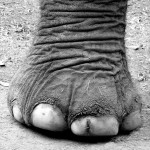by Adrienne Mayor  (Wonders & Marvels contributor)
(Wonders & Marvels contributor)
Georges Cuvier (1769-1832), the father of modern paleontology, was the first European naturalist to articulate a scientific theory of extinction, based on his studies proving that mastodons and mammoths were the prehistoric ancestors of living elephants. (Mastodons and mammoths went extinct 10,000-6,000 years ago.) This crucial advance in understanding the fossils of long extinct creatures came about in part because of Cuvier’s deep knowledge of ancient cultures’ discoveries of mammoth and mastodon fossils in Mediterranean lands and in the New World.
Cuvier gathered every known account of “giant bones” in classical literature and he also maintained an extensive archive of Native American discoveries and legends, sent to him by various Euro-American colonists and explorers. Yet the influence of ancient accounts of “the stone bones of giants and monsters” and the contributions of Native American observations of remarkable tusks, molars, and bones on Cuvier’s thinking are unappreciated today. One reason is that the leading historian of paleontology, Martin Rudwick, in his translations of Cuvier’s essential works into English (1997), omitted Cuvier’s French essays describing his avid curiosity about Native American fossil traditions. This omission leads recent commentators on Cuvier’s theories, such as Elizabeth Kolbert (“Annals of Extinction,” New Yorker, December 16, 2013), to overlook a significant body of evidence, one that Cuvier himself acknowledged.
Cuvier relied on friends and travelers in the Americas to send him every scrap of evidence they heard from Native Americans about petrified teeth, bones, and tusks found in the ground. They also sent him many actual specimens of fossils which he eagerly examined in Paris. The first mastodon femur and molars to be studied in Europe had been discovered by Indian guides on the Ohio River in 1739 (another little-known fact in the history of paleontology). Specimens like these were crucial to Cuvier’s theory. But one object shipped across the Atlantic was just too good to be true.
Cuvier described the startling specimen from America in 1821 (Recherches sur les ossemens fossiles). The crate contained a mastodon tooth with pointed cusps—and a rotting front pachyderm foot complete with five toenails. According to the letter inside, the relics had been discovered in a cave by “les sauvages” living “west of the Missouri river.” Cuvier’s informant had purchased them from a comanchero (Mexican trader) who said he had obtained it from an Indian tribe. “But this foot was fresh!” It looked as though it had been “hacked from an elephant carcass,” noted Cuvier. “This find—if authentic—was almost enough to make one doubt that mastodons were extinct!”
Ever the scientist, Cuvier remarked: “I could not refrain from suspecting a fraud.” These specimens were displayed in Paris in the early 19th century but they no longer exist. The hoax from America was clever, since it combined a recognizable fossil mastodon tooth with a “fresh” elephant foot. One mystery remains: where did the foot come from? Possibly it had been removed from a well-preserved mammoth (not mastodon) carcass naturally mummified in a dry desert cave. But it seems more likely that it was taken from a recently deceased circus elephant. Elephants were being exhibited in America by the end of the 18th century.
About the author: Adrienne Mayor is a Research Scholar in Classics and History of Science, Stanford University. She is the author of “The First Fossil Hunters: Dinosaurs, Mammoths, and Myth in Greek and Roman Times (2000, 2011); “Fossil Legends of the First Americans” (2005); and “The Poison King” (2010), a National Book Award nonfiction finalist.
